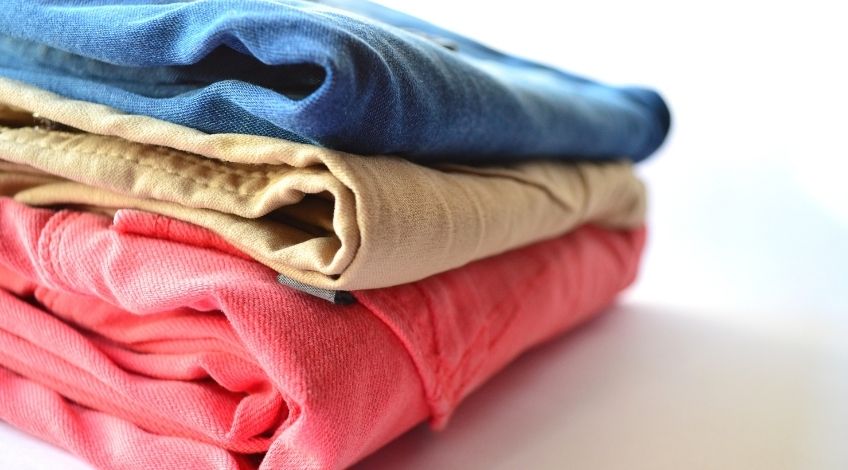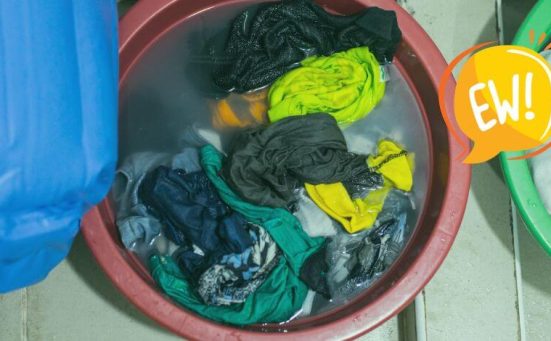
Holes In Clothes After Washing? (read this)
Have you found holes in your clothes after they’ve been washed that you never noticed before putting them in the washing machine? Do you wonder what’s caused the holes? So did we and so we did some research, this is a summary of what we found.
What Others Assume Is Causing The Holes
We did extensive research and it turns out this is quite a common problem. Not just here in the UK, but in many other countries as well. Judging by the comments we found, many people lay the blame on their washing machines. So that’s where we started our investigations, and we found nothing in the design of a washing machine that could have caused the random holes appearing in so many clothes.
Bra Wires
However, we did find instances where bra wires had broken and got caught in the drum of the washing machine. These sharp pieces of wire then snag on items of clothing causing them to rip or tear, leaving small holes in clothes. It seems this happens more with cheaper bras and we can only assume they’re not made to be tumbled about in a washing machine.
That could have been the end of our investigations, case closed. If it wasn’t for the fact that many cases reported categorically stated there were no bras, cheap or otherwise, in the washing machines at the time the holes appeared. So we dug deeper and what we uncovered might surprise you.

What Causes Holes To Appear In Clothes In The Washing Machine?
We discovered that apart from bra wires, there are a number of reasons that perfectly sound clothes leave the washing machine with holes. And it’s hardly ever the actual washing machine that’s caused the problem. It could be any of the following;
Bleach
If neat bleach comes into direct contact with the laundry it can burn through the fabric, causing holes to appear. If you use bleach in your wash, always ensure it is completely dissolved in water before adding it to the machine.
Stain Removers
If you use stain removers, always follow the instructions carefully. Leaving the stain remover on the garment for too long can cause holes to appear in clothes.
Incorrect Use Of Detergents
If you always use a low priced, low quality detergent it can cause the fabrics to fray over time and they are then far more likely to get holes. Using the wrong detergent on wool or silk garments will cause irreparable damage. Especially if the garments are then washed using the wrong cycle and too fast a spin speed.
Zips And Hooks
If you put items of clothing in a mixed wash that have zips or hooks, ensure they are fully fastened beforehand and turn the garments inside out before washing. Zips and hooks can catch on other garments and cause them to form holes as they tumble in the drum of the machine. To prevent damage you should always;
- Ensure all zips and hooks are fastened before they go into the machine
- Turn all zipped items inside out
- Place clothes that have hooks in laundry nets to prevent them catching on other clothes.
Grains Of Sand/Stone etc…
It might sound ridiculous, but believe it or not, a grain of sand can cause holes to appear in clothes in the washing machine. The grain of sand combined with the detergent can pull on the threads on delicate materials and cause a hole to form. The sand could have come from the spinning mill where your garment was made.
Insects And Larvae
Certain insects like silverfish (Lepisma saccharinum) which are attracted to dark, moist places can set up home in your washing machine. If they are desperate enough they will eat cotton clothing. They only make microscopic holes which would go unnoticed as you load the machine.
The process of washing the clothes could then cause these microscopic holes to enlarge, causing the holes that you first notice after the clothes have been washed.
To prevent silverfish from nibbling at your clothes, don’t allow your clothes to touch the bathroom floor as this is a favourite haunt for silverfish and other damp loving insects. Leaving the washing machine door open for a couple of hours after the wash has finished will help to dry the drum out and deter these pesky critters. Running a hot service wash once a month will help to remove silverfish and other bacteria.
Moths
Or more specifically, moth larvae which feed on organic materials like wool, silk, cotton, linen, etc… Especially on clothing that’s been left for some time. It is not always possible to spot a moth infestation as many types prefer to run instead of flying making them harder to detect.
Foreign Bodies
Any loose pocket items like keys, screws, nails, even coins can all cause clothes to rip or tear and form small (and sometimes not so small) holes. Screws, nails and keys are obvious hole causers. Coins on the other hand, can cause damage to the paddles on the drum which can then snag on clothes as they tumble around in the machine.
Overloading Your Washing Machine
If you cram too much washing into the drum, you run the risk of allowing some garment(s) to get caught between the door seal and the drum. As the drum rotates, these items will get ripped.
Incorrect Spin Speed
There are some garments that cannot be spin dried at all, others that need a slow spin speed and so on. If you put a delicate item on a fast spin, it has the potential to rip the fabric. Always check the garment label for the correct spin speed and wash cycle. If the label has been removed or has faded, here is a generic guide to the correct spin speeds for various garments;
| Garment | Spin Speed Revolutions Per Minute (rpm) |
|---|---|
| Silks | 400 rpm |
| Shirts | 600 rpm |
| Delicates | 600 rpm |
| Denim | 900 rpm |
| Minimum Iron | 1200 rpm |
| Woollens | 1200 rpm |
| Cottons | 1400 rpm |
For more information on the correct wash cycles for your machine refer to your handbook or contact the manufacturer.

Mixing Different Types Of Clothes In The Wash
One of the best ways to help prevent holes in clothes during the washing and drying process is to sort clothes correctly before placing them in the machine. For instance, mixing heavy denim clothes in a wash with delicate lace or silk garments can cause damage during the rough and tumble of the washing process.
How To Protect Delicate Clothes In A Mixed Wash
If you have to do a mixed load, place any delicate items in a mesh laundry bag before putting it in the machine. This will protect the garment from getting damaged during the rough and tumble of the washing machine’s regular cycle.
Holes In T-Shirts
If it’s only t-shirts that are coming out of the machine with holes, it’s possible the cause is either just regular wear and tear or it’s rubbing against a belt, denims, or even a hard surface like a kitchen worktop or office desk.
Poor Quality Clothes
We all like a bargain, but there’s an old and very wise saying that says;
“If it seems too good to be true – It probably is”
Buying really cheap t-shirts and the like is great, but don’t expect them to last too long before the cheap threads start to come apart, which causes holes to appear.
Rough Surfaces
If you happen to catch your clothes on a rough surface like a rough wooden fence, brick wall etc… It can be just enough to cause slight damage to a thread or two, which once it gets thrown about in the washing machine, could cause a hole to appear.
Belts, Braces And Other Embellishments
If you wear a belt or braces or anything that could catch on the fabric of your clothes, it’s possible that these have slightly damaged the fabric. This could cause a hole in the material. Once you identify the culprit, it might be possible to smooth the abrasive surface using sandpaper or a metal file.
Deodorants
Many people spray their clothes with deodorant, especially the top they’re wearing. Some deodorants contain chemicals that could cause damage to some fabrics.
Damaged Washing Machine Drum
It is possible for the drum to become damaged by any number of metal objects as stated above. Inspect the drum by running your hand all over the drum’s surface. If you feel any rough spots this could be causing the problem. Also the plastic paddles could be damaged, it only takes a small nick to catch on clothes.
To check the drum correctly, wrap a nylon stocking around your hand and run it all over the surface of the drum. The nylon will show any snag and you’ll be able to get it sorted either yourself or by contacting a washing machine repairer.
Possible Problems With The Tumble Dryer Drum
If the washing has dark streaks that look almost like burn marks as well as small holes and/or broken threads, it could be the tumble dryer drum. If the drum is not in perfect alignment, material could slip between the drum and the dryer housing which can cause damage to your clothes.

The Washing Machine Can’t Damage Clothes
That’s a bold statement, and for the most part it’s true. Sure, clothes can get damaged in the washing machine, but in 99 cases out of 100, it’s caused by human error. The other 1% will be where something you have allowed to access the machine has caused the damage. But in most cases, it’s down to human error, either;
- Selecting the wrong program
- Mixing delicates with non delicates
- Incorrect use of detergent
- Too much stain remover
- Undiluted bleach
- Non removal of keys, screws, nails etc…
- Belt, braces or other embellishments catching on the fabric
- Material already damaged before going into the machine
- Using spray deodorants on the fabric
It’s always easier to blame an inanimate object for something we never had time to do or just forgot. But the reality is usually our fault and not the washing machine. If it is the machine, it can usually be fixed fairly simply, just call an engineer and they will get it sorted for you.
Frequently Asked Questions
Jeans and other denim items should be washed on a cycle with a 900 rpm spin speed.
If you want to add delicate items to a mixed wash, they should be placed in a mesh laundry bag to protect them from heavier, rougher garments. The whole wash should be washed at a spin speed that corresponds with the care label of the delicate items.
One of the ways to get rid of silverfish from a washing machine is to run a hot wash which should help to remove any insects and bacteria.
If your washing is coming out of the washing machine with holes in them, it’s more than likely not your washing machine that’s causing the problem. It’s more than likely down to human error. Something like, using the wrong detergent, using an incorrect spin speed, overloading the machine, washing underwire bras in with a regular wash, allowing foreign bodies like keys, screws, etc… into the machine along with the washing, using too much stain remover or undiluted bleach.
It is possible that some spray deodorants can damage clothes if the deodorant is sprayed directly onto the material.
Also, follow us on Pinterest ...



